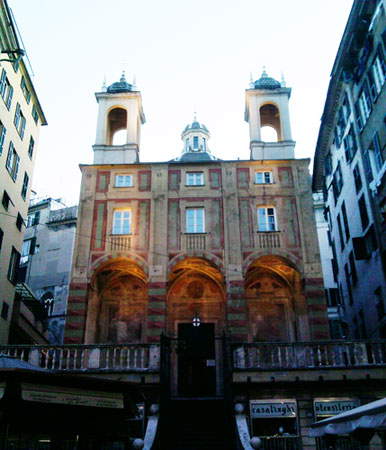Among the various surprises that the alleys of Genoa ’s historic center hold, there is a very special one indeed: the church of San Pietro in Banchi. Getting there is very easy: from Piazza Caricamento just leave Palazzo San Giorgio on the right and walk straight ahead for a few dozen meters. There you will find the church on the right.
The most obvious peculiarity of this church consists in the fact that it is built over some stores: the reason for this more unique than rare solution refers us to the history of the building. On the site of the church that we can admire today, there was another, very old one (it was built long before the year 1000: apparently in 972) that was called San Pietro della Porta, and whose memory lingers today in a street that is called precisely “via di San Pietro della Porta.” Indeed, right in the square where the church stands today was one of the ancient gates to the city, and the church of San Pietro della Porta, given its proximity to the port, was the one where all those who came to Genoa by sea stopped.
However, in 1398, a clash between different political factions led to the destruction of the church, which fell into ruin during a fire. Two centuries later, in 1572, at the end of a plague that had plagued the city, it was decided to rebuild it: construction was completed eight years later. We are in the heyday of the economy of the Republic of Genoa: part of the construction, however, had to be self-financed. It was thus that the idea was conceived to complete the church with the funds obtained from the rent of the workshops that were opened in the premises made inside the basement on which the church itself stood. The idea was successful, the workshops were rented out, and the church could be completed! The Genoese thus showed no small amount of modernity, and even today the premises of the basement are used for commercial activities.
 And besides, it was an important church, because the square on which it stands, Piazza Banchi, was the center of economic activity in ancient Genoa. Today it stands before us with its severe appearance, but softened by trompe l’oeil decorations, or those whereby architectural elements, instead of being real, are painted. Columns, cornices, balustrades, terraces: all painted, from a distance it looks like marble, but in reality they are paintings! This technique is very common in Liguria due to the fact that the salty air of the sea could be harmful to many materials used in architecture (but there are also those who think it is due to the proverbial thriftiness of the people of these lands!).
And besides, it was an important church, because the square on which it stands, Piazza Banchi, was the center of economic activity in ancient Genoa. Today it stands before us with its severe appearance, but softened by trompe l’oeil decorations, or those whereby architectural elements, instead of being real, are painted. Columns, cornices, balustrades, terraces: all painted, from a distance it looks like marble, but in reality they are paintings! This technique is very common in Liguria due to the fact that the salty air of the sea could be harmful to many materials used in architecture (but there are also those who think it is due to the proverbial thriftiness of the people of these lands!).
The whole church is built on this basement-terrace, and is connected to the square by a grand staircase: all this contributes to a sense of grandeur to the building, enhanced by the two bell turrets we observe on either side of the facade. A facade divided into three parts, which are marked by the three large arches of the portico, and a facade characterized by the colors red and green (as well as the white of the faux architecture). The design was conceived by architect Bernardino Cantone, who showed that he was openly inspired by a well-known design by the more famous Perugian (but also active in Genoa) architect Galeazzo Alessi, namely the Basilica of Santa Maria Assunta in Carignano, probably the most imposing church in the city (it is visible from many parts of Genoa and is one of the first buildings one notices coming from the sea!).
Further back, we see the outline of the dome silhouetted. Past the portico, we make our way to the interior, which has a single nave with side chapels but is especially sumptuous: there are magnificent marble decorations (real this time!), stuccoes, valuable masterpieces of 16th- and 17th-century Genoese art. We have an Immaculate Conception by Andrea Semino (which is in the chapel dedicated precisely to the Immaculate Conception), we have statues by Taddeo Carlone and Daniello Casella, we have frescoes by Andrea Ansaldo. The altarpiece, on the other hand, is by Cesare Corte, and the protagonist is, of course, St. Peter.
Warning: the translation into English of the original Italian article was created using automatic tools. We undertake to review all articles, but we do not guarantee the total absence of inaccuracies in the translation due to the program. You can find the original by clicking on the ITA button. If you find any mistake,please contact us.